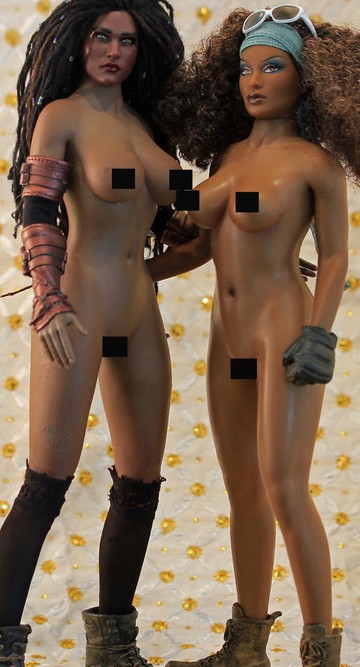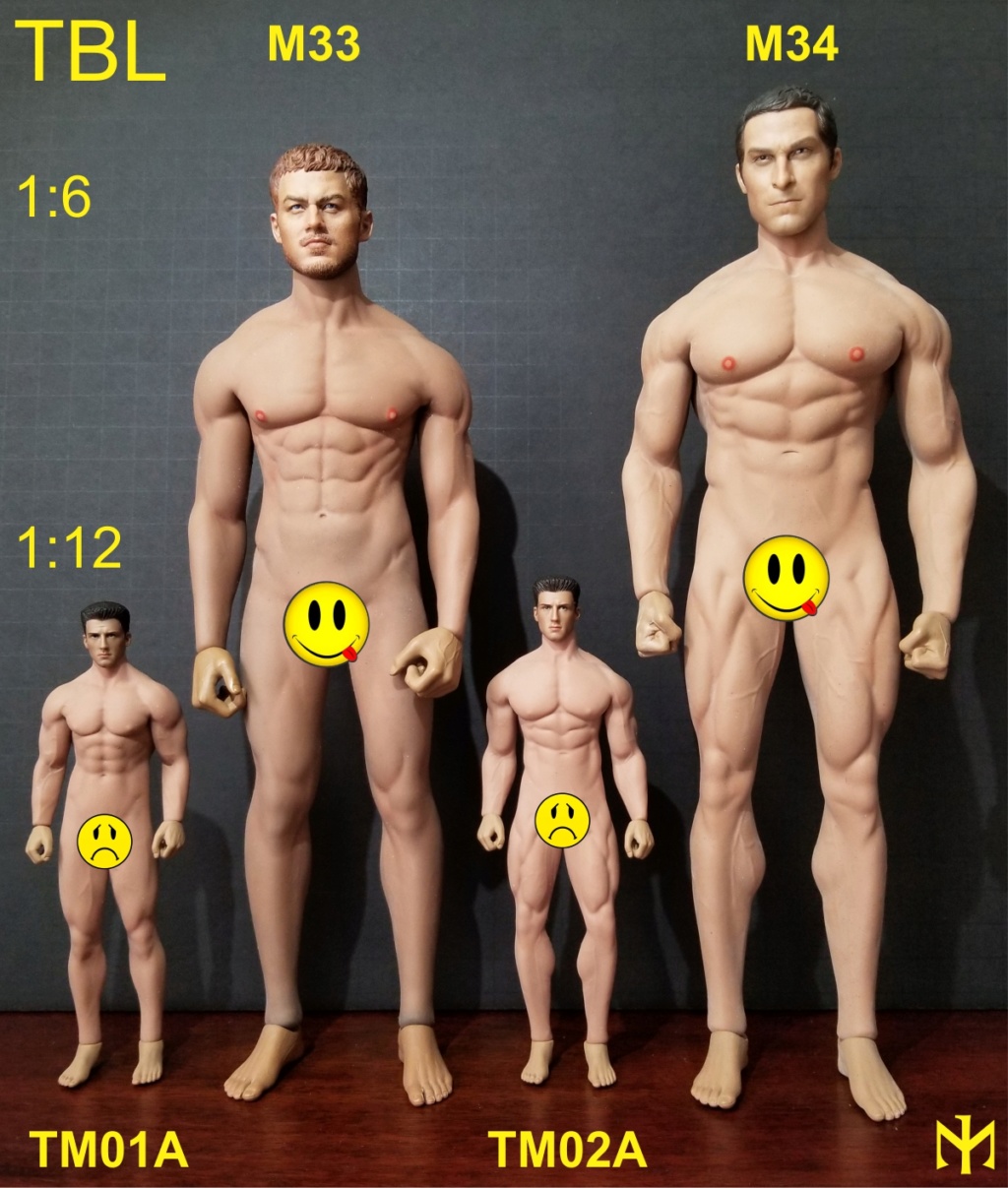Well, they both look lighter in one of the photos, so some of this has to do with lighting. Either way, I still think it looks great.
OneSixthFigures

An online community to discuss and share news about sixth-scale figures, with an emphasis on either custom or commercial articulated figures.
Go to page :  1, 2, 3, 4, 5
1, 2, 3, 4, 5 
 Re: Dyeing Phicen figures with Rit Dye (NSFW) Thu Feb 20, 2020 1:25 am
Re: Dyeing Phicen figures with Rit Dye (NSFW) Thu Feb 20, 2020 1:25 am Re: Dyeing Phicen figures with Rit Dye (NSFW) Thu Feb 20, 2020 4:59 am
Re: Dyeing Phicen figures with Rit Dye (NSFW) Thu Feb 20, 2020 4:59 am Re: Dyeing Phicen figures with Rit Dye (NSFW) Thu Feb 20, 2020 8:20 am
Re: Dyeing Phicen figures with Rit Dye (NSFW) Thu Feb 20, 2020 8:20 am Re: Dyeing Phicen figures with Rit Dye (NSFW) Thu Feb 20, 2020 8:23 am
Re: Dyeing Phicen figures with Rit Dye (NSFW) Thu Feb 20, 2020 8:23 am Re: Dyeing Phicen figures with Rit Dye (NSFW) Sat Feb 22, 2020 5:00 pm
Re: Dyeing Phicen figures with Rit Dye (NSFW) Sat Feb 22, 2020 5:00 pm
 Re: Dyeing Phicen figures with Rit Dye (NSFW) Sat Feb 22, 2020 5:42 pm
Re: Dyeing Phicen figures with Rit Dye (NSFW) Sat Feb 22, 2020 5:42 pm Re: Dyeing Phicen figures with Rit Dye (NSFW) Sat Feb 22, 2020 6:13 pm
Re: Dyeing Phicen figures with Rit Dye (NSFW) Sat Feb 22, 2020 6:13 pm
 Re: Dyeing Phicen figures with Rit Dye (NSFW) Sun Feb 23, 2020 5:00 pm
Re: Dyeing Phicen figures with Rit Dye (NSFW) Sun Feb 23, 2020 5:00 pm


 Re: Dyeing Phicen figures with Rit Dye (NSFW) Sun Feb 23, 2020 5:28 pm
Re: Dyeing Phicen figures with Rit Dye (NSFW) Sun Feb 23, 2020 5:28 pm Re: Dyeing Phicen figures with Rit Dye (NSFW) Sun Feb 23, 2020 5:57 pm
Re: Dyeing Phicen figures with Rit Dye (NSFW) Sun Feb 23, 2020 5:57 pm
 Re: Dyeing Phicen figures with Rit Dye (NSFW) Sun Feb 23, 2020 6:02 pm
Re: Dyeing Phicen figures with Rit Dye (NSFW) Sun Feb 23, 2020 6:02 pm Re: Dyeing Phicen figures with Rit Dye (NSFW) Fri Feb 28, 2020 5:06 pm
Re: Dyeing Phicen figures with Rit Dye (NSFW) Fri Feb 28, 2020 5:06 pm Re: Dyeing Phicen figures with Rit Dye (NSFW) Fri Feb 28, 2020 5:39 pm
Re: Dyeing Phicen figures with Rit Dye (NSFW) Fri Feb 28, 2020 5:39 pm Re: Dyeing Phicen figures with Rit Dye (NSFW) Fri Feb 28, 2020 5:55 pm
Re: Dyeing Phicen figures with Rit Dye (NSFW) Fri Feb 28, 2020 5:55 pm Re: Dyeing Phicen figures with Rit Dye (NSFW) Sun Mar 08, 2020 4:49 pm
Re: Dyeing Phicen figures with Rit Dye (NSFW) Sun Mar 08, 2020 4:49 pm


 Re: Dyeing Phicen figures with Rit Dye (NSFW) Sun Mar 08, 2020 7:05 pm
Re: Dyeing Phicen figures with Rit Dye (NSFW) Sun Mar 08, 2020 7:05 pm Re: Dyeing Phicen figures with Rit Dye (NSFW) Sun Mar 08, 2020 7:28 pm
Re: Dyeing Phicen figures with Rit Dye (NSFW) Sun Mar 08, 2020 7:28 pm
 Re: Dyeing Phicen figures with Rit Dye (NSFW) Sun Mar 08, 2020 7:36 pm
Re: Dyeing Phicen figures with Rit Dye (NSFW) Sun Mar 08, 2020 7:36 pm Re: Dyeing Phicen figures with Rit Dye (NSFW) Sun Mar 08, 2020 8:13 pm
Re: Dyeing Phicen figures with Rit Dye (NSFW) Sun Mar 08, 2020 8:13 pm Re: Dyeing Phicen figures with Rit Dye (NSFW) Mon Mar 09, 2020 5:18 am
Re: Dyeing Phicen figures with Rit Dye (NSFW) Mon Mar 09, 2020 5:18 am Re: Dyeing Phicen figures with Rit Dye (NSFW) Tue Mar 10, 2020 5:44 am
Re: Dyeing Phicen figures with Rit Dye (NSFW) Tue Mar 10, 2020 5:44 am Thank you Tue Mar 24, 2020 4:00 pm
Thank you Tue Mar 24, 2020 4:00 pm Re: Dyeing Phicen figures with Rit Dye (NSFW) Tue Mar 24, 2020 5:06 pm
Re: Dyeing Phicen figures with Rit Dye (NSFW) Tue Mar 24, 2020 5:06 pm My Experience Tue Mar 24, 2020 6:06 pm
My Experience Tue Mar 24, 2020 6:06 pm








 Re: Dyeing Phicen figures with Rit Dye (NSFW) Tue Mar 24, 2020 6:26 pm
Re: Dyeing Phicen figures with Rit Dye (NSFW) Tue Mar 24, 2020 6:26 pm Re: Dyeing Phicen figures with Rit Dye (NSFW) Tue Mar 24, 2020 6:38 pm
Re: Dyeing Phicen figures with Rit Dye (NSFW) Tue Mar 24, 2020 6:38 pm

 Re: Dyeing Phicen figures with Rit Dye (NSFW) Tue Mar 24, 2020 7:46 pm
Re: Dyeing Phicen figures with Rit Dye (NSFW) Tue Mar 24, 2020 7:46 pm Re: Dyeing Phicen figures with Rit Dye (NSFW) Tue Mar 24, 2020 9:06 pm
Re: Dyeing Phicen figures with Rit Dye (NSFW) Tue Mar 24, 2020 9:06 pmMaster, your Padawan used 1 whole brown bottle and half a red bottle. Can't thank you enough for this education.The skintone on yours looks like it came out a lot more even than mine did. How much dye did you put into the pot? wrote:
First, thank you for the welcome, Ovy. I used the hands from a Storm Toys basketball figure. The female heads: 1 is a Triad Toys head customized by Corsetkitten years ago. 2 is an old Barbie head.Welcome Titan! Great job, this Rit Dye option really opens tons of possibilities. That last guy looks epic, could totally see him in an old spice commercial. I guess you used M36 hands. What headsculpts did you use for the girls? wrote:
GubernatorFan, I used a Prismacolor pen.Very nicely done, Titan! They seem to have come out pretty flawless and have helped you make quite the entrance. By the way, what did you do to paint the nipples a darker color? wrote:
 Re: Dyeing Phicen figures with Rit Dye (NSFW) Tue Mar 24, 2020 9:25 pm
Re: Dyeing Phicen figures with Rit Dye (NSFW) Tue Mar 24, 2020 9:25 pmGo to page :  1, 2, 3, 4, 5
1, 2, 3, 4, 5 
Similar topics
Permissions in this forum:
You cannot reply to topics in this forum